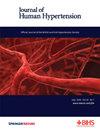血液中的炎症指数及其与吸烟者高血压的关系:利用数据挖掘方法进行分析。
IF 3.4
4区 医学
Q2 PERIPHERAL VASCULAR DISEASE
引用次数: 0
摘要
尽管有报告称吸烟与高血压患者炎症标志物水平升高之间存在关联,但尚未在大型现代队列中使用数据挖掘方法进行前瞻性评估。我们对 Mashad 试验进行了横断面分析,该试验具有前瞻性。研究对象为 2085 名 35 至 65 岁的吸烟者。测量的炎症指数包括血红蛋白-血小板比值(HPR)、尿酸-高密度脂蛋白(HDL)比值(UHR)、中性粒细胞-淋巴细胞比值(NLR)、系统免疫炎症(SII)指数、白细胞、血小板-淋巴细胞比值(PLR)和红细胞分布宽度(RDW)。研究还探讨了这些参数与高血压患者吸烟之间的关系。在为期 6 年的监测期间,共有 585 人患有高血压,其中大多数为女性(59%)。根据 LR 分析,女性吸烟者的高血压与年龄、白细胞、SII、PLR,以及男性吸烟者的年龄和 PLR 之间存在显著关联。(p 值本文章由计算机程序翻译,如有差异,请以英文原文为准。

Blood indices of inflammation and their association with hypertension in smokers: analysis using data mining approaches
Although there have been reports on the association between smoking and increased level of inflammatory markers in hypertensive this has not been assessed prospectively in a large, modern cohort using data mining approaches. We conducted a cross-sectional analysis of the Mashad trial which was a prospective. 2085 smokers aged 35 to 65 years was studied. Inflammatory indices measured included: Hemoglobin-Platelet Ratio (HPR), Uric acid-high Density Lipoprotein (HDL) Ratio (UHR), Neutrophil-Lymphocyte Ratio (NLR), Systemic Immune Inflammation (SII) index, WBC, Platelet-Lymphocyte Ratio (PLR), and RBC Distribution Width (RDW). The association between these parameters and smoking in hypertensive individuals was examined. Over the course of the 6-year monitoring period, 585 peoples had HTN of whom the majority was female (59%). As per the LR analysis, there was a significant association between hypertension and age, WBC, SII, PLR in female smokers, as well as age and PLR in male smokers. (p-value < 0.05). PLR (OR = 0.993, CI 95% (0.987, 0.999)) and age (1.080 (1.058, 1.102)) for male and WBC (1.340 (1.139, 1.577)) and age (1.091 (1.070, 1.113)) for female exhibits the most appropriate estimate. Using the DT model for male individuals, those with, age ≥ 64 years, and SII < 336 had the correlated with hypertension prevalence (76%). For females, those with age ≥ 62 years, WBC ≥ 6.1, and SII < 445.634 had the highest risk of HTN. Age and SII for smoker males and age and WBC for smoker females showed the strongest correlation with hypertension. Age and WBC were the most significant indicators for predicting HTN.
求助全文
通过发布文献求助,成功后即可免费获取论文全文。
去求助
来源期刊

Journal of Human Hypertension
医学-外周血管病
CiteScore
5.20
自引率
3.70%
发文量
126
审稿时长
6-12 weeks
期刊介绍:
Journal of Human Hypertension is published monthly and is of interest to health care professionals who deal with hypertension (specialists, internists, primary care physicians) and public health workers. We believe that our patients benefit from robust scientific data that are based on well conducted clinical trials. We also believe that basic sciences are the foundations on which we build our knowledge of clinical conditions and their management. Towards this end, although we are primarily a clinical based journal, we also welcome suitable basic sciences studies that promote our understanding of human hypertension.
The journal aims to perform the dual role of increasing knowledge in the field of high blood pressure as well as improving the standard of care of patients. The editors will consider for publication all suitable papers dealing directly or indirectly with clinical aspects of hypertension, including but not limited to epidemiology, pathophysiology, therapeutics and basic sciences involving human subjects or tissues. We also consider papers from all specialties such as ophthalmology, cardiology, nephrology, obstetrics and stroke medicine that deal with the various aspects of hypertension and its complications.
 求助内容:
求助内容: 应助结果提醒方式:
应助结果提醒方式:


